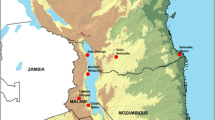Abstract
The aim of the Integrated Cassava Project (ICP) of the International Institute of Tropical Agriculture was to pre-emptively manage the cassava mosaic disease (CMD) to avert an imminent and increasing possible threat of the Ugandan strain of the CMD virus of the pathogen from doing damage to the Nigerian cassava economy. The strategy was to engage in activities that would lead to cultivar-substitution by replacing the susceptible varieties on farmers’ fields with superior genotypes that are not only CMD resistant or tolerant but also high yielding with good dry matter content. A fast track participatory selection approach was used in 2 years to release nine new lines in Nigeria. It was intensive and several lessons were learnt. The varieties released after 2 years were TMS 98/0510, TMS 98/0581, TMS 97/2205, TMS 98/0505, TME 419, TMS 92/0326, TMS 96/1632, TMS 98/0002, and TMS 92/0057.



Similar content being viewed by others
References
ESRI (1999) ArcView GIS software, version 3.3. for Windows. Environmental Systems Research Institute, Inc. Copyright © 1992–2002
FAO (1984) Food and Agriculture Organization of the United Nations. Nationally Coordinated Research Projects. Consultancy report of S.V.S. Shastry, 28 pp
Ikwelle MC, Ezulike TO, Eke-Okoro ON (2001) The contribution of root and tuber crops to the Nigeria economy. In: Akoroda MO (ed) Proceedings of 8th symposium of the international society of tropical root crops—Africa Branch. IITA, Ibadan, Nigeria
NACGRAB (2004) Crop varieties released and registered in Nigeria. National Centre for Genetic Resources and Biotechnology Moor Plantation, Ibadan, 40 pp
Nweke FI, Ugwu BO, Dixon AGO, Asadu CLA, Ajobo O (1999) Cassava production in Nigeria: a function of farmer access to markets and to improved production and processing technologies, COSCA working Paper No. 20, IITA, Ibadan, Nigeria
Ogbe FO, Dixon AGO, Hughes Jd’A, Alabi F, Okechukwu RU (2002) The status of cassava mosaic disease, cassava begomoviruses and whitefly vector populations in Nigeria. Internal technical report, IITA, Ibadan, Nigeria
SAS (2003) SAS/STAT software, version 9.1. for Windows. Copyright © 2002–2003 by SAS Institute Inc., Cary, NC, USA. Licensed to International Institute of Tropical Agriculture (IITA)
Yan W (2001) GGEBiplot-a Windows application for graphical analysis of multi-environment trial data and other types of two-way data. Agron J 93:1111–1118
Acknowledgements
The authors acknowledge the funding of Federal Government of Nigeria, Niger Delta Development Commission, United States Agency for International Development, and Shell Petroleum Development Company of Nigeria. We also acknowledge the team of monitors who ensured that OFTs and DEMO conducted via the ADPs were well executed, NRCRI, Root and Tuber Expansion Program, ADPs, Federal Ministry of Agriculture and Rural Development, universities, AGIP oil company in Nigeria, private corporate farms, and all farmers who participated in the evaluation process.
Author information
Authors and Affiliations
Corresponding author
Rights and permissions
About this article
Cite this article
Dixon, A.G.O., Akoroda, M.O., Okechukwu, R.U. et al. Fast track participatory approach to release of elite cassava genotypes for various uses in Nigeria’s cassava economy. Euphytica 160, 1–13 (2008). https://doi.org/10.1007/s10681-007-9487-2
Received:
Accepted:
Published:
Issue Date:
DOI: https://doi.org/10.1007/s10681-007-9487-2




